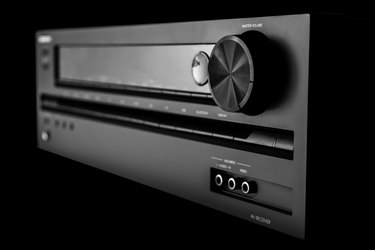
Denon manufactures and sells high-end audio-video receivers for home theater applications. Noted for their sleek design, power and multiple options for connecting components, Denon receivers can provide many years of excellent performance. If your Denon receiver ever malfunctions, try these strategies for troubleshooting the problem.
Power Problems
Video of the Day
Denon receivers are equipped with a microprocessor that initializes the audio and video settings when the unit is powered on. Occasionally, you may find the component cuts off when it is turned on because the protection circuit is confused by the microprocessor, so the Denon shuts off. The simple fix for this problem is to unplug the receiver from the power, then press and hold the "Direct" and "Stereo" buttons on the front of the component simultaneously while plugging the power cord back in. Wait for the display to flash on the front of the receiver, and then release the buttons. This should reset and initialize the microprocessor so the receiver will stop cutting off every time you turn it on.
Video of the Day
For other power problems, make sure the Denon receiver is securely plugged into a power strip or wall outlet. Also check the batteries in the remote control and replace if necessary.
Audio Connections
Denon receivers offer an array of connection options for hooking up components--via RCA cable jacks, HDMI and USB ports, docking station connections for an iPod, composite and S-video inputs for connecting a high-definition television. If something goes wrong, try to isolate the problem to a specific component. For example, if the Denon powers up and plays tunes off a docked iPod, but you cannot get movies to play on the DVD or Blu-Ray component, the problem is most likely a bad connection between the Denon and the DVD or Blu-ray player. It takes only a few minutes to check the cables connecting your audio-video equipment to the Denon receiver. All plugs should be pressed firmly into their corresponding jacks. With HDMI, USB and S-video cables, make sure to orient the plug in the proper direction before attempting to insert it into the jack.
For speaker problems, set the Denon to "Surround Sound" mode using the remote control, and then activate the test function to hear a white noise from each speaker connected to your system. If the sound skips a speaker, you have isolated the problem to a specific speaker channel. Check the speaker cable between that channel and the Denon receiver.
Settings and Controls
Given the complexity and multitude of component connections on Denon receivers, it only takes one random push of a remote control button to change the settings on the receiver and potentially block a component from working. If the kids have been gaming but forgot to change the input setting back to where it was before they were using your equipment, you may suddenly find that the CD changer cannot be operated by the Denon receiver's remote control or the DVD player displays no image on your television. Check the input setting on the Denon remote to make sure it is set to DVD if you want to watch a movie with the DVD player. Similarly, if the television input control is changed to a setting not directly connected to the Denon receiver, you will not be able to view anything played from any component connected to the Denon. So if the Denon receiver is connected to the television's Input 1, use the TV remote to switch the set back to Input 1.